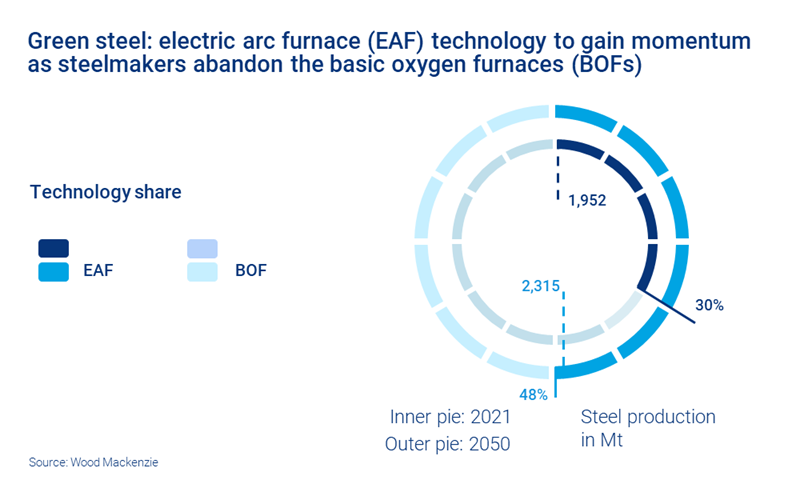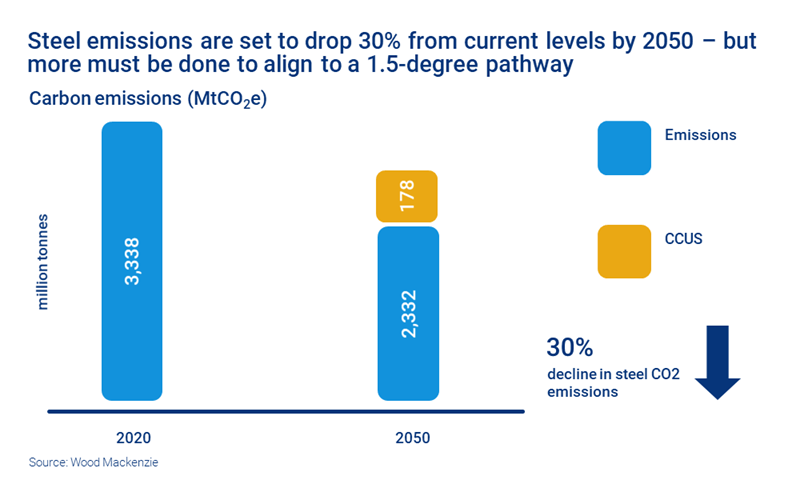与我们分析师联系
Green steel: three milestones on the road to lower carbon emissions
Steel emissions will drop 30% by 2050 – but more transformative change is needed to keep pace with an accelerated energy transition
1 minute read
Malan Wu
Vice President, Global Head of Assets, Metals and Mining Research

Malan Wu
Vice President, Global Head of Assets, Metals and Mining Research
Malan is an experienced commodities professional with strengths in commodity analysis and commercial strategy.
Latest articles by Malan
View Malan Wu's full profileWith steelmaking accounting for at least 7% of global carbon emissions, pressure is mounting for the industry to decarbonise. That will radically alter the supply landscape and require huge capital outlay, as well as significant technical collaboration and support from external stakeholders. So, how is the industry moving towards greener steel – and is it enough to align to a 1.5 degree pathway?
The recent report Steel’s decarbonisation journey: what, when and how? draws on unique insight from our Steel Research Suite. Visit our store to access the full report – or read on for a quick insight into three key things to know about steel’s greener future.
1. Electric arc furnaces using zero-carbon electricity will come to dominate steelmaking
We believe more efficient electric arc furnace (EAF) technology, which is three-quarters less emission-intensive than a traditional blast furnace, will eventually dominate steelmaking. By 2050, we expect EAF production to be nearly on a par with (currently dominant) basic oxygen furnaces (BOF), as steelmakers gradually distance themselves from the conventional route.
The transition will be uneven, however. The onus will be on mature economies including China, Europe, Japan, South Korea and the US to decarbonise quickly. China will take the lead, halving its absolute emissions over the next 30 years thanks to both lower demand and more efficient production. In contrast, India and Southeast Asia – the key drivers of future demand – will buck the trend, doubling their emissions due to a tripling of output via the heavy emitter blast furnace route.
2. Scrap will emerge as the primary metallic for steelmaking
Using scrap in an EAF with a clean power source has the potential to be a near-zero emission route. That makes scrap the most sought-after metallic, and we expect demand for scrap to increase three times faster than overall metallics demand. Quality enhancements and retrofits will also potentially increase scrap blending in blast furnaces.
China will be a key consumer of scrap, lowering its dependence on hot metal in line with other major economies. However, there are limitations on the availability of scrap, as well as on quality improvements. That pivots the industry towards exploring new ways of abating emissions.
3. Hydrogen-based steel production will eventually account for 10% of global output
The use of hydrogen in steelmaking has real potential, although it is still a nascent technology and has yet to be exploited at a commercial scale. We project that by 2050, 40% of direct reduced iron (DRI) will be produced using a hydrogen as reductant.
The EU will take the lead in terms of adoption – Sweden in particular looks likely to be a trailblazer for net zero aligned steel production with green hydrogen at its heart. ArcelorMittal and SSAB are planning to commercialise the technology in 2026-27, having already conducted successful pilot tests. That will pose challenges including the availability of DR-grade pellets, refining to eliminate hazardous impurities, and the requirement for higher capital investment. As a result, adoption is likely to be slow in cost-sensitive markets.
Hydrogen also has potential for use in the BOF process as a partial replacement for the pulverised coal injection (PCI) method. That is unlikely to happen on a commercial scale until the early 2040s, but once it does it should quickly gain momentum, since the technology can be retrofitted to existing blast furnaces.
We expect that hydrogen-based steel production will account for 10% of the total steel output by 2050, while carbon capture, utilisation and storage (CCUS) will help offset nearly 178 Mt of emitted carbon.
Steel emissions will plummet – but is it enough?
How much of an impact will these developments have? We forecast a 30% reduction of overall emissions – 25% at gross level and 5% offset via CCU – at the same time as steel production increases by 20%. That’s significant progress, but on this trajectory, emissions will still be around ten times higher than the level needed for a 1.5-degree global warming pathway (our AET1.5 scenario).
Steelmakers are taking positive steps on the road to decarbonisation, and we’ll be tracking their progress closely. But much larger strides are needed. It is an uphill task, but progress can be accelerated through setting collective targets, increasing collaboration between governments, industry, and academia, and ensuring adherence to formidable action items.
Find out more about the future of green steel
This article is an extract from Steel’s decarbonisation journey: what, when and how? Visit our store to get the full report, which contains in-depth analysis of the long-term demand outlook, the role of hydrogen, the impact of carbon offsetting, and comparison of the base-case emissions outlook against an AET1.5 scenario.


